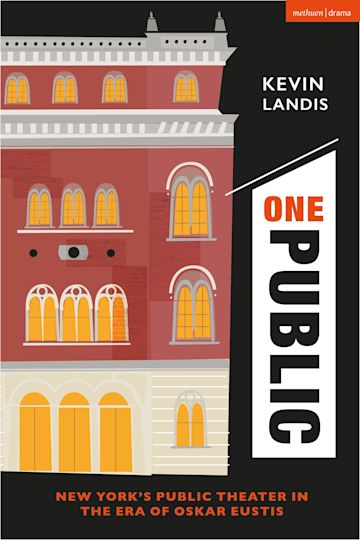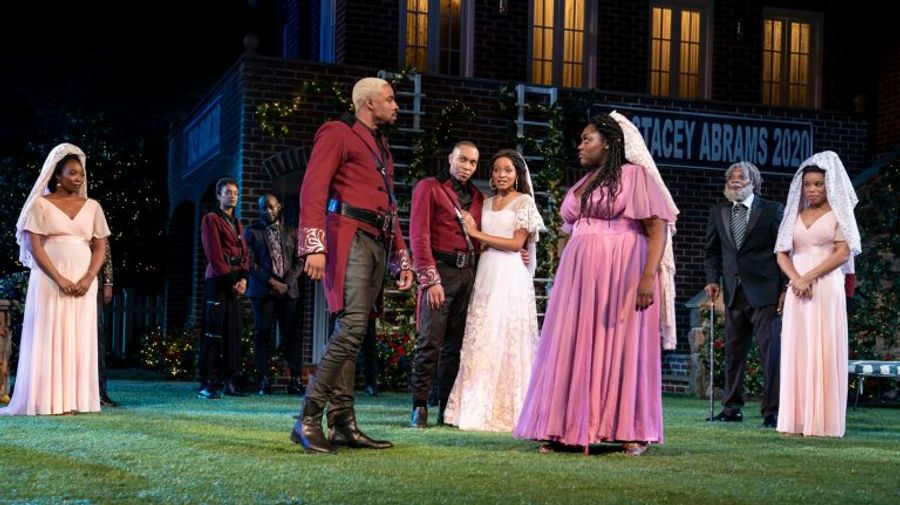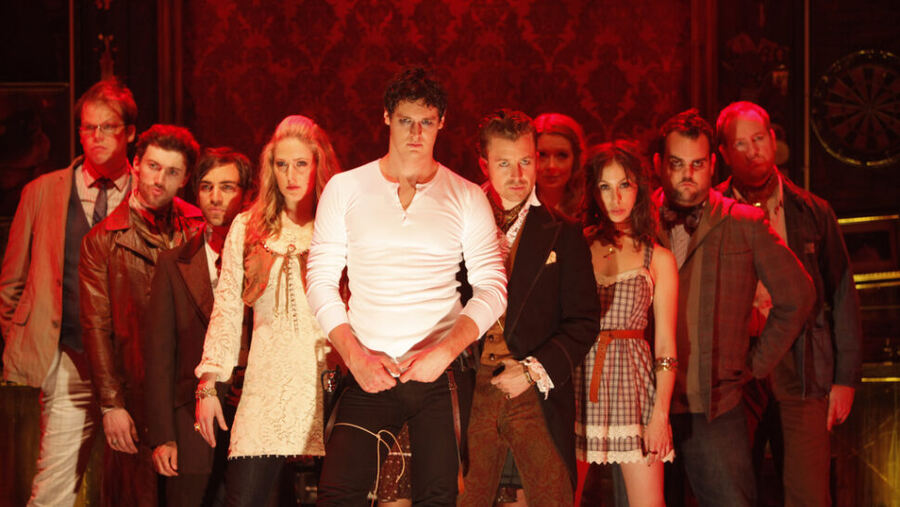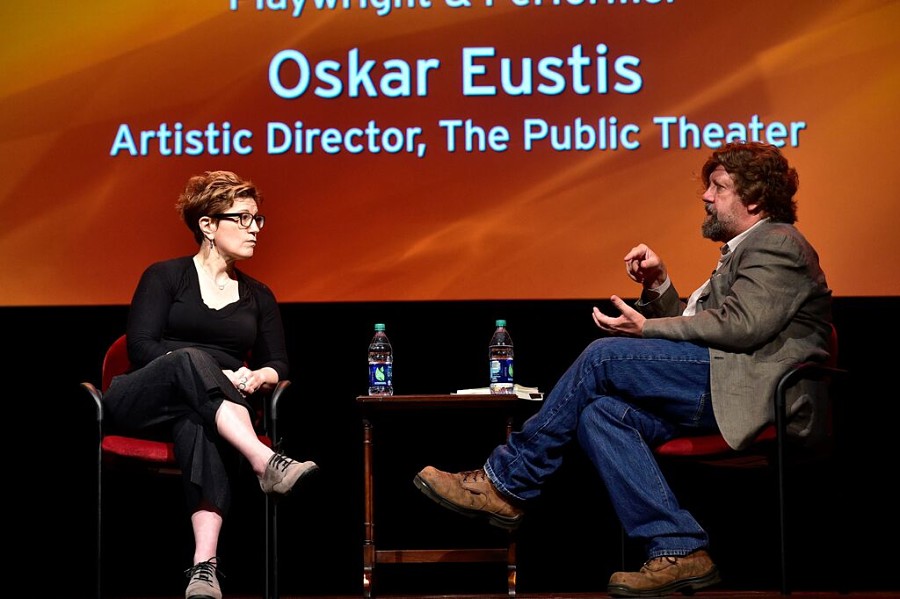After a few days in a hospital for respiratory problems in 2020, Oskar Eustis returned to find that his theatre had been closed. It would be the opening salvo of the most difficult year of his professional life.

One Public is the first book to hold a mirror up to an American theatre in the pandemic era. Completed in 2022 by their scholar-in-residence (author Kevin Landis now calls himself a “visiting scholar”), it’s an insider’s profile of an organization often labeled “America’s national theatre” and its esteemed artistic director, and of the airtight alignment of his and the theatre’s identity and values. The book’s question—faced to some degree by many artistic directors—is how an institution can hold to its guiding principles during a time of unprecedented upheaval. Though Kevin Landis is writing about his former teacher, mentor, and hero, One Public is thankfully not a work of hagiography.
He characterizes Oskar Eustis as a staunch idealist, a leftist who proudly carries his late mother’s Communist Party card in his wallet, and a brilliant intellectual known to call a staff meeting to argue about Artistotle’s Poetics. Primarily a dramaturg, he came to the position with a reputation as an adroit collaborator with playwrights. In 2005 he took over the seat held by George C. Wolfe, first molded by the titanic Joseph Papp. While leading the Public, Wolfe continued his active directing career. After his tenure, the theatre’s board of directors pointedly chose an institution builder rather than a leading artist, the better to reaffirm the founder’s commitment to “radical inclusivity” while having both eyes set firmly on the bottom line.
The Public may be the only remaining major American theatre that operates according to proudly articulated left-wing principles. On a wall in the offices hangs a sign proclaiming, “Artists are a force for change; culture belongs to everyone.” Radical inclusivity encompasses productions downtown as well as Shakespeare in the Park. Eustis describes the Public’s most storied venue, the Delacorte Theatre, as a type of socialist experiment, free and open to all—New York City’s great equalizer.
Landis contrasts the artistic director’s idealistic rhetoric with his penchant for downplaying the financial realities of a privileged neighborhood and a deeply stratified city. Access issues are created by short runs and the struggle to score tickets, despite a lottery system—unless you happen to be a donor or corporate sponsor. Representing “the epicenter of wealth and privilege,” Central Park’s location makes it difficult to draw those with limited time and resources from other boroughs. Plans for a much larger theatre have proven too costly.
In keeping with Papp’s social justice mission, Eustis has made the “spirit of the times his artistic muse.” In the historically conventional Delacorte repertoire, he has added politically resonant productions: an all-female Taming of the Shrew, Tony Kushner’s adaptation of Mother Courage, the Al Pacino Merchant of Venice, and most recently all-Black productions of Merry Wives, Much Ado, and Richard III.
Eustis’s return to directing, his notorious 2017 Julius Caesar in the Park, made a good case for preaching to the choir and raising the red flag of autocracy. But there was some miscalculation here: He must have known that having a Trump lookalike as Caesar and setting the bloody assassination scene in the Senate was bound to raise the ire of reactionaries. And it did, drawing national headlines and morning talk-show prattle. But the right soon stole the story with bootleg videos of the stabbing that aired on Fox and Breitbart News; when a protestor rushed the stage, the Public added security. In failing to anticipate the reaction and respond vigorously, the Public never regained the media offensive.
Some of Papp’s spirit lives on in the epic jamborees under the banner of Public Works, held each summer at the Delacorte for some years now. Created and piloted by Lear deBessonet, Public Works builds long-term partnerships with social service groups, unions, and even prisons, who gather in classes throughout the year in preparation for an annual musical version of a classic text, usually Shakespeare. The program follows Papp’s directive to “go to the people,” and, like the similarly community-minded Mobile Unit, harks back to the peripatetic origins of the New York Shakespeare Festival, when actors took the Bard to city parks in a converted sanitation truck.
Papp would surely also have been proud of the 2018 tour of Sweat, Lynn Nottage’s Pulitzer winner, which played an extended run at the Public before a Broadway run and, more importantly, a move into the heartland. Eustis described the tour as a “dramatic attempt to break out of our New York bubble and speak to those who the nonprofit theatre has largely ignored: the rural communities of the Upper Midwest.” The production mostly played non-theatrical venues without stage lighting or the price of admission.

Like Papp, Eustis has demonstrated loyalty to a coterie of artists, presenting nearly every play written by Kushner, Suzan-Lori Parks, and Richard Nelson. He also remedied the theatre’s glaring dearth of female playwrights by staging work by Lisa Kron, Julia Cho, Danai Gurira, Rinne Groff, Sarah Burgess, Lynn Nottage, and Erica Dickerson-Despenza. The Public had been famously closed to all but established playwrights, an issue Eustis addressed with the Emerging Writers Group. In order to be considered for the program, a playwright must have no agent and no New York production history.
In the U.S., dramaturgy has often meant period research and a study of a playwright’s oeuvre. At the Public, thanks to the artistic director’s experience and the theatre’s resources, it consists of a lengthy relationship with the playwright, workshops followed by studio productions, and, if all goes well, a full production. In a thorough examination of the process, Landis describes how plays are made “in tandem with the audience.” Each week of a studio showing contains several full days of rehearsal and performances on only three or four nights. It’s an enviable approach to making new plays, and it has set an influential industry standard.
At the end of the day, though, a New York artistic director is often judged by the hits he’s produced. Based on that measure Eustis has certainly delivered. Joe Papp’s Public may not have lasted without A Chorus Line, and it might not have survived the pandemic without Hamilton. That show’s Broadway, Australian, and touring companies currently contribute $25 million to the theatre’s annual budget. Though it had a much more modest success, an unlikely musical about an artist drawing her biography became the brilliant Fun Home. And Here Lies Love, the David Byrne-Fatboy Slim musical about Imelda Marcos, was a popular success d’estime that has finally found a Broadway house for a summer run.
Hamilton was an instant sensation when it opened at the Public in January 2015, playing to a sold-out run. Since a Broadway slot was available in the spring, a decision had to be made whether or not to build on overwhelming word of mouth and open in April before the deadline for Tony eligibility. Kail, Miranda, and the rest of the team lobbied for more rehearsal time to make the changes they all felt were necessary. In Jeffrey Sellers, who was attached to the show from the beginning, they found a commercial producer who was on the same artistic page. Miranda had two other reasons for delaying a Broadway transfer: He wanted to honor the agreement to run at the Public through the spring, and he wasn’t interested in going up against that season’s other Public-bred Broadway musical, Fun Home.
The move paid off: One year after Fun Home won the best musical Tony, Hamilton followed suit in 2016 and took home a Pulitzer as well. The Oskar Eustis brand was assured. To explain how a theatre of “deep social justice” is partly made possible by the deep pockets of Broadway, he said: “The contradiction is consciously managed.”
It wasn’t always that way. In its early years the Public was the sole producer of its Broadway transfers, leaving it open to a $5 million bath with 1998’s On the Town. After that debacle, the straight-to-Broadway The Wild Party, and the swift and costly closing of Bloody Bloody Andrew Jackson on Broadway in 2011, the theatre formed Public Theater Productions, a parallel production entity by which the theatre partners with commercial producers who can offer opinions but have to respect the process downtown before assuming the Broadway costs.
Bloody Bloody wasn’t just a financial setback for the theatre. Alex Timbers and Michael Friedman’s deliberately sophomoric satire of 21st-century populism lampooned the seventh president as a crude, racist emo rocker. The downtown run of the show received glowing reviews, found a young audience, and extended multiple times. That runaway success led Eustis to overlook objectionable material, in particular Jackson’s forcible displacement and slaughter of Native Americans. Caricatures of “Indians” meant to skewer Jackson’s racism had a very different effect on Native American audience members at the show’s Broadway run. And the timing couldn’t have been worse: A recently established Native Theater Initiative in partnership with the Ford Foundation was an important component of the Public’s inclusivity enterprise. Bloody Bloody embarrassed the theatre and the Foundation.
Eustis tried to embrace the criticism, even flying in Native Americans from around the country to see and critique the show. It was a sincere gesture but only added salt to the wound. Shouting matches erupted during the show and scuffles broke out in the lobby.
Controversy, Landis writes, “is the foundation upon which the organization is constantly reified and rebuilt.” What he calls “the price of being the Public” is the way virtually everything the theatre does is measured against the goals of radical inclusivity, social justice and equity, and culture for everyone.

Calendar year 2020 brought the ultimate test of those goals, as a powerful racial reckoning coincided with the grimmest economic environment the American theatre had ever faced. A $30 million reserve fund gave the Public a financial cushion most theatres lacked. But then ferment by theatremakers of color, identifying as Black, Indigenous, or people of color (BIPOC), dealt leadership a devastating blow. A few months after the theatre’s closing, on June 8, a manifesto was sent by the BIPOC group to the artistic director. Incited by what they called white-centric programming and staffing, their “Letter from the Margin” was a blunt rebuke and a call to action. At a time of repeated violence against Black people, they wrote, “[we] cannot make sense of the ways in which the Public has structured its priorities and operations within the aforementioned contexts that, for our communities, amount to life and death.” Part of the context was the murder of George Floyd on May 25 and the Public’s failure to quickly acknowledge its significance.
A full staff meeting was held. Tensions ran high and continued that way for months. “The anger toward Eustis was pointed and personal,” reports Landis. The artistic director felt the BIPOC group wanted him to suffer and relinquish power. The Public may have been more diverse than virtually any other New York theatre, but the bar, as one BIPOC group member stated, was lying on the ground. It wasn’t hard to get over. They were just asking the theatre to pick it up.
Numerous meetings led to the acknowledgement that the Public wasn’t living up to its mission. It had become a relentless production machine that overworked staff and disregarded equity, inclusion, and respect. The dysfunction was a result of brilliant minds, lots of money, and “an unending ambition of expansion, expansion.” Eustis spent that June and July feeling “scared, reactive, and filled with self-doubt.” His self-image and identity as a radical progressive leader had been challenged. He remembers the summer of 2020 as a nightmare that he struggles with on a daily basis.
The pandemic only heightened the turmoil. Staff needed to be furloughed, raising the question of who constituted an essential employee. A conflict around equity and justice now included the top-down leadership structure. Following in the footsteps of Papp and Wolfe, Eustis was the third charismatic male autocrat to run the theatre. (That JoAnne Akalaitis helmed the theatre for just two years in the 1990s only proves the point.) The genius model of leader no longer squared with the Public’s values. Under pressure, Eustis moved to broaden decision-making. He assembled an associate artistic director team consisting of Mandy Hackett and two BIPOC leaders, Saheem Ali and Shanta Thake (Thake was named chief artistic office of Lincoln Center in 2021 and has since been replaced at the Public by Freedome Bradley-Ballentine). The new structure is likely to be a work in progress for some time.
In an otherwise forthright portrait of the Public, there is one puzzling omission. Immediately following the pandemic, a musical reopened the theatre and the fall 2021 season. Landis mentions a dispute over the use of an accent but doesn’t identify the actor or the production. He chooses instead to write briefly about the online rumor-mongering and demands for transparency that dogged the opening.
The musical was The Visitor, based on a 2008 indie film, and the incident involved an actor, Ari’el Stachel, who refused to use a Syrian accent because his character had grown up in the U.S. After his departure, the show paused for a week before previews to allow the creative team time to address, as the Public stated, areas of concern raised by other company members over depictions of race and representation. The show that finally opened was trimmed and eviscerated by critics. Why this naive and politically incorrect tale was on the Public stage after the crisis of 2020 was a question that needed to be asked.
In a final, wide-ranging interview, Eustis muses on theatre’s role in American life, and how programs like Public Works and the Mobile Unit might share the joys of making theatre with a wider population. The conversation turns intimate as the artistic director hopes his legacy will be a “dogged desire to open pathways and support artists.” He also admits to responding to his son Jack’s death by suicide in 2014 by becoming distant from the staff. That reaction, he believes, was a factor in underestimating how opaque decision-making had become and ultimately to minimizing the need to grapple with racial inequity.
The Public’s leadership role in the field and the challenge of adhering to its increasingly relevant principles make One Public a compelling case study. As American theatre in the 2020s stands on “the ledge of survival,” this book will be an instructive read for anyone interested in knowing how the field can endure.
Michael Bloom (he/him) is the author of Thinking Like a Director and a new adaptation of Nathan the Wise.
The original version of this article stated that the Public was Kevin Landis’s employer; in fact, he is employed by the University of Colorado, and paid for the research and writing of One Public himself. It also stated that Eustis is himself a “card-carrying Communist.”


